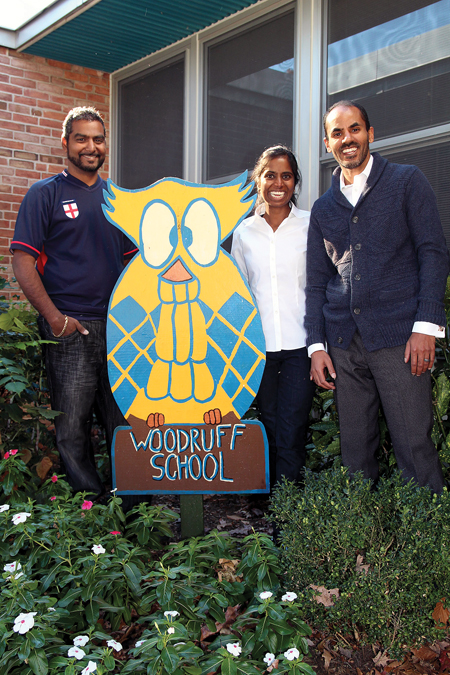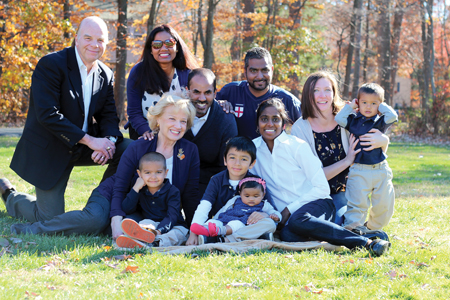Identity: Learning To Be Indian

Despite being born in India, I’ve been navigating my relationship with my Indianness my whole life.
[Left] A.J. Bryant, at the age of one, with his parents who had just adopted him from Kerala.
Generally, Indians don’t know how to react to me. I look like them, but I’m not one of them. I was born in 1979 in Kerala, but was adopted by American parents. I came to the United States in 1980.
I grew up in Madison, Wisconsin, mostly uprooted from Indian culture. There were sporadic connections to my beginnings, though. As a child, my parents took me to Indian cultural events organized by the India Students Association at the University of Wisconsin. Every year, we also attended a Christmas party in Milwaukee that was organized for adopted Indian children in Wisconsin by Holt International, the adoption agency of my siblings. The highlight was an Indian Santa Claus. I remember my sister having a henna artist at one of her birthday parties as a child. All the girls were white except one other Indian adoptee.
I rarely ate Indian meals growing up. I had never heard of paneer until I was in my late teens. My mom cooked tandoori chicken on my adoption anniversary, June 15. Otherwise, I had Indian food a handful of times a year. The only Indian friends of my childhood, besides my siblings, were also adopted. Beyond a few family gatherings a year, I had no sustained interactions with Indians.
I am American by nature, attitude, cultural affinity, language, and customs. But with brown, Indian skin. I was raised in the white world. That’s my lingua franca. The majority of my friends are non-Indians. I think like a Westerner, not an Indian. I am comfortable in social situations where I am the only brown person or person of color. In fact, it’s a common occurrence. I notice it more as an anomaly, especially as I age. But, long ago, I made peace with its sometimes awkward nature.
Most of my friends would say they forget that I’m Indian. They relate to me as any other American guy they know, albeit with an interesting background. My “Indianness” doesn’t stick out to them, because culturally I’m like them.
I don’t hang out with other Indians. My English is not peppered with Hindi. I’m not part of any desi community. My name isn’t Indian sounding, nor do I have an accent. My degrees are in political science and international relations. My aptitude for math, science, or engineering is wholly absent. My family members aren’t doctors or engineers. And you don’t want me near your computer.
However, my parents knew the importance of India in our lives. We always talked about the family dream of all five of us visiting India. My parents wanted me and my siblings to experience the land of our birth and connect with our roots. We did indeed travel to India in 2001. It was the first time since my infancy I’d touched Indian soil.
We visited landmarks, walked the streets, and even met people at my sister’s orphanage who remembered her. The trip was a life-changing event for me. I spent time in the town of my birth, Kottayam. I saw people that looked like they could be my relatives. I came away from the experience hungry to live there as an adult.
[Right] With his siblings, also adopted: Bethany, from Pune, and Benjamin, from Aurangabad.
What’s he asking me?
My desire to experience India as an adult came to fruition in 2011 when I interned for a human rights NGO in South Delhi. One day, after work, I went to a local restaurant and ordered take-out. Usually, when I spoke to an Indian, they picked up on my lack of accent immediately and switched to English. This man did not.
The man behind the register kept asking me the same question repeatedly. Many people came to the counter and picked up their food. I stood there awkwardly trying to understand what the owner was saying. Feeling a mix of shame and frustration, I finally asked a customer, “What is he asking me?” They looked at me as if I had three heads and said, “He’s asking if you want a takeout box, otherwise he will put your food in a bag.”
You may laugh. And I do now. But when it occurred, it was humiliating. Here I was in the land of my birth. I looked and was dressed similarly to the men that were coming in the restaurant, and yet, I couldn’t communicate. I have rarely felt more helpless.
Sometimes, I explain why I don’t speak the language, even though it’s not their business. I don’t feel obligated to tell strangers my story. But at the same time, I own it and I would rather endure an interrogation than have people make up my narrative.
When people realize I can’t talk with them in Hindi or another Indian language, I become the “other.” Even if I tell them the reason why I don’t speak the language, I am no longer considered part of their tribe—if I ever was. They treat me as an outsider, or worse, an oddity.
Embracing my evolving Indian Identity
Where I differ from my white friends is that I can attend a Diwali celebration, Holi, or Republic Day festivities without looking out of place. I may not know the language or cultural cues, but I look like I belong.
Despite the fact that I’m not culturally Indian, I’m proud of my ethnic heritage. I identify as an Indian-American. I take pride in the continued development of the country and its larger impact on the world stage.
My wife, Sasmita, is an Indian immigrant from Odisha who grew up in a small village hundreds of miles from the capital city of Bhubaneswar. I married Sasmita in 2012. We have two children together. Now that I’m married to an Indian, people look to me as a window into Indian culture. They ask me where to go for Indian food, and which Indian movies or Netflix shows to watch. They read news about India and then ask my opinion about it. It’s strange to be a cultural authority for my non-Indian friends when, for all my life, that wasn’t my role.
I sometimes feel fraudulent, as if I’m not the person they should be asking about these things. But then I realize that this is another progression of my identity. Now I’m the father of two brown kids with a culturally Indian wife and people look at me differently.
We’re trying to raise our children with the understanding that they are from both Indian and American cultures. Sasmita speaks to our children in her mother tongue, Oriya. She’s introducing them to Odisha foods she ate and other Indian fares. We acknowledge Indian Republic Day and Independence Day. We play Holi with people in our community.There are always Hindi songs playing in our car or on Pandora. I applaud multicultural endeavors and it’s a rich environment for our children. Sasmita’s entire family lives in India and we visit every couple of years.
They may all seem silly examples, but none of those elements were part of my upbringing. I don’t know how to raise someone as a traditional Indian or what that upbringing looks like. But I want our kids to be comfortable with Indian culture and not to see its people, language, and customs as strange or unfamiliar, as it was sometimes for me. I dread the day in the future when I come home from work and all three of them tease me in a language that I don’t understand.

AJ, his wife (in sunglasses), daughter (baby in the front), along with his parents and other family members, in a photo from six years back.

… and a recent one with AJ’s son, wife, parents, and his sister and her child.
The importance of identity formation for transnational adoptees
Identity formation is important. We seek it out as a desirable characteristic for a mate. We say things like “he/she has a strong sense of who they are,” and extoll that virtue. We gravitate towards people who have an innate sense of self. That is something Western society rewards. We believe that if you have strong roots or identity, that means you’re a resilient person.
But for transnational adoptees like me, this concept is fraught. We don’t always have a strong sense of identity because some of us don’t know our exact beginnings. I’ve spent my whole life piecing together who I am. And it’s not been a tidy exercise. I’ve taken fragments—being Indian, adopted, and American—and melded them together to create me.
But I recognize that who I am may not align with how others see me. There’s an element of this identity incongruence with everyone, but for adoptees, it’s amplified. Perception, as they say, is reality. And when people look at me, they see a brown Indian guy who doesn’t fit with their vision of what an Indian guy should behave or sound like. Sometimes, I enjoy throwing people for a loop. Being adopted is one segment of my identity. Being Indian is another. And I’m also American. I don’t have to claim a single identity and I do not.
A.J. Bryant is a transracial adoptee from Kerala, India, and the eldest of three adopted Indian children. Raised in Wisconsin and New Jersey, he has called Washington, D.C. home since 2005. AJ is an adoption writer and speaker, bringing a unique perspective on identity, culture, and family as a male, Indian adoptee. He can be found on Twitter @adoptedkeralite, Instagram @adoptedkeralite, and Medium.com.
Enjoyed reading Khabar magazine? Subscribe to Khabar and get a full digital copy of this Indian-American community magazine.
blog comments powered by Disqus











